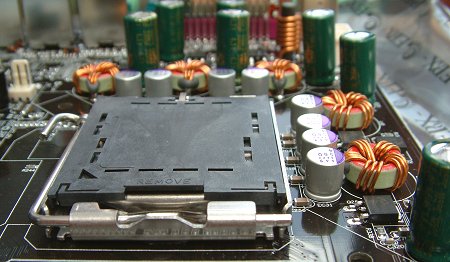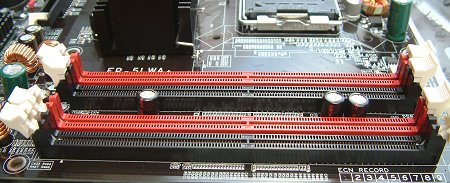Layout and features

The first thing that hits you about the 5LWA+ is the colour. The black PCB, which is a nice departure from EPoX's usual green, is set against ports and sockets that are coloured according to their purpose. For example, PCI slots are all red, PCI-Express x1s all yellow, and DIMM slots either red or black. It makes intuitive sense, as your eye is automatically drawn to same-coloured ports. Installation for novices is also that bit easier. The initial impression is of a board that's been sensibly designed.

There's ample room around the LGA775 CPU socket on the left-hand side, but mounting a reference cooler is made just a little tricky on the north-east side. Two capacitors block access to the mounting hole, and it then becomes difficult to push the cooler's clip down without having to worry about moving capacitors to one side. A little more room here would have been appreciated. The mid-board location of the 24-pin power connector frees up space around the socket/DIMM area, making for effortless installation. I do like EPoX's use a passive heatsink to cool the 266MHz-ratified northbridge. There's little worse than listening to 40mm fan spinning at 6,000RPM. A couple of the board's three fan headers are near enough the CPU to be useful for decent CPU-based cooling.

Lots of room around here, and the added benefit of not having to remove a video card when changing DIMMs. As per i925XE spec., you can install a maximum 4GB of DDR2 RAM that's run in dual-channel mode. For the majority of Intel CPUs that run at 200MHz FSB, memory can be set to a matching DDR2-400 or to DDR2-533. Just to the left of the DIMM slots is a reviewers' favourite; power and reset buttons located right on the motherboard. Great for testing in an out-of-case environment, and also useful when tinkering with the system.

EPoX adds in another useful feature by incorporating a debug LED display right next to the clear CMOS jumper. It cycles through a number of codes during the POST sequence. Should POST fail, usually because an overclock has gone awry, the debug LED will stop at a code that can be cross-checked against the manual. Useful for troubleshooting when you're not quite sure what the hold-up is. 4 orange SATA ports all belong to the ICH6/R southbridge. There's no additional RAID in either SATA or PATA forms. That'll either be a cost saving or serious omission, depending upon your likely board usage. For most users, though, 4 SATA ports is enough, especially with 400GB drives now widely available. I also like the colour-coded motherboard-to-case pins. These make installation a touch easier. i925XE boards usually ship with just a single (2-channel) ATA100 IDE port. The 5LWA+ is no exception. It's all about SATA now, although EPoX does include a SATA-to-PATA convertor in the 5LWA+'s bundle.
EPoX uses Realtek's proven ALC880 8-channel CODEC to route Intel's high-definition audio out to the back panel. HDA is a marked improvement over AC'97, and most i925XE boards team it up with CODECs from either Realtek or CMI. Storage may be sparse when considered in relation to other equivalent boards but networking isn't. EPoX implements two Marvell Yukon 88E8053 controllers run off PCI-Express x1 lanes. Expansion-wise, there's a couple of yellow-coloured PCI-Express x1 and three standard PCI slots. Again, this should be enough for most users. If you take a look at the red header just between the CMOS battery and x16 PCIe slot, it's designed to run EPoX's Thermo Stick temperature-measuring sensor, which is included in the package. Handy if you want to measure the temperature of the graphics card, memory, or MOSFETs.

4 out of the 5LWA+'s 8 USB2.0 ports are available from the back panel. A couple of I/O connectors on the board push the total to the available 8. Both optical and coaxial S/PDIF-out connectors are available, with inputs accessed by an optional bracket and onboard headers. 8-channel sound and dual RJ45 sockets round off a decent back panel. The 5LWA+'s 2-port VIA VT6307 FireWire controller's ports are run off an included bracket, and hence not available here.
All in all, a decent array of features that have been sensibly located on the 5LWA+. First-class layout will help novice and experience users alike.









